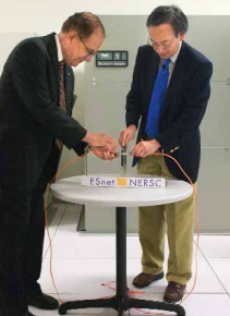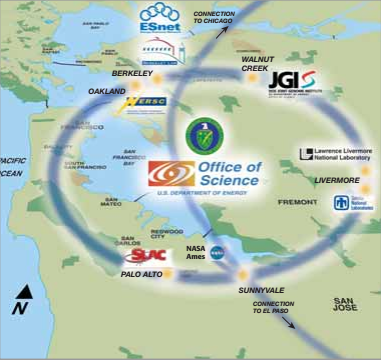NERSC Is First Production Site on ESnet’s Bay Area MAN
August 1, 2005

DOE Office of Science Director Raymond Orbach (left) and LBNL Director Steven Chu made the ceremonial connection between NERSC and ESnet in June. After testing, the full production connection was launched this month.
On August 23, the NERSC Center became the first of six DOE research sites to go into full production on ESnet’s new San Francisco Bay Area Metropolitan Area Network (MAN). Once completed, the new MAN will provide dual connectivity at 20 to 30 gigabits per seconds (10 to 50 times the current site bandwidths, depending on the site using the ring) while significantly reducing the overall cost. The connection to NERSC consists of two 10-gigabit Ethernet links. One link will be used for production scientific computing traffic, while the second is dedicated to special networking needs, such as moving terabyte-scale datasets between research sites or transferring large datasets which are not TCP-friendly.
“What this means is that NERSC is now connected to ESnet at the same speed as ESnet’s backbone network,” said ESnet engineer Eli Dart.
The new architecture is designed to meet the increasing demand for network bandwidth and advanced network services as next-generation scientific instruments and supercomputers come on line. Through a contract with Qwest Communications,the San Francisco Bay Area MAN will provide dual connectivity to six DOE sites – the Stanford Linear Accelerator Center (SLAC), Lawrence Berkeley National Laboratory, the Joint Genome Institute (JGI), NERSC, Lawrence Livermore National Laboratory and Sandia National Laboratories/California. The MAN will also allow high-speed access to California’s higher education network (CENIC), NASA’s Ames Research Center and DOE’s R&D network, Ultra Science Net.
 All sites are scheduled to be connected by September. The Bay Area MAN will connect to both the existing ESnet production backbone and the first segments of the new Science Data Network backbone.On August 23, the NERSC Center became the first of six DOE research sites to go into full production on ESnet’s new San Francisco Bay Area Metropolitan Area Network (MAN). Once completed, the new MAN will provide dual connectivity at 20 to 30 gigabits per seconds (10 to 50 times the current site bandwidths, depending on the site using the ring) while significantly reducing the overall cost.
All sites are scheduled to be connected by September. The Bay Area MAN will connect to both the existing ESnet production backbone and the first segments of the new Science Data Network backbone.On August 23, the NERSC Center became the first of six DOE research sites to go into full production on ESnet’s new San Francisco Bay Area Metropolitan Area Network (MAN). Once completed, the new MAN will provide dual connectivity at 20 to 30 gigabits per seconds (10 to 50 times the current site bandwidths, depending on the site using the ring) while significantly reducing the overall cost.
The connection to NERSC consists of two 10-gigabit Ethernet links. One link will be used for production scientific computing traffic, while the second is dedicated to special networking needs, such as moving terabyte-scale datasets between research sites or transferring large datasets which are not TCP-friendly.
“What this means is that NERSC is now connected to ESnet at the same speed as ESnet’s backbone network,” said ESnet engineer Eli Dart.The new architecture is designed to meet the increasing demand for network bandwidth and advanced network services as next-generation scientific instruments and supercomputers come on line. Through a contract with Qwest Communications,the San Francisco Bay Area MAN will provide dual connectivity to six DOE sites – the Stanford Linear Accelerator Center (SLAC), Lawrence Berkeley National Laboratory, the Joint Genome Institute (JGI), NERSC, Lawrence Livermore National Laboratory and Sandia National Laboratories/California. The MAN will also allow high-speed access to California’s higher education network (CENIC), NASA’s Ames Research Center and DOE’s R&D network, Ultra Science Net.
All sites are scheduled to be connected by September. The Bay Area MAN will connect to both the existing ESnet production backbone and the first segments of the new Science Data Network backbone.
About NERSC and Berkeley Lab
The National Energy Research Scientific Computing Center (NERSC) is a U.S. Department of Energy Office of Science User Facility that serves as the primary high performance computing center for scientific research sponsored by the Office of Science. Located at Lawrence Berkeley National Laboratory, NERSC serves almost 10,000 scientists at national laboratories and universities researching a wide range of problems in climate, fusion energy, materials science, physics, chemistry, computational biology, and other disciplines. Berkeley Lab is a DOE national laboratory located in Berkeley, California. It conducts unclassified scientific research and is managed by the University of California for the U.S. Department of Energy. »Learn more about computing sciences at Berkeley Lab.







